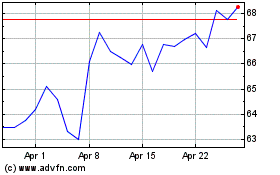Rinehart to Flood Iron-Ore Market With Fresh Supply
December 03 2015 - 7:10AM
Dow Jones News
SYDNEY—As iron ore collapses to a decade low, in remote
northwest Australia one of the world's richest women is preparing
for the first cargo of the commodity from her massive new mine to
set sail.
Gina Rinehart's Roy Hill iron-ore mine, which has been years in
the making, will pour millions more tons of the steelmaking
commodity into the global market at a time when concerns about
oversupply have driven prices to US$40 a metric ton for the first
time since 2005.
On Thursday, the value of the commodity tumbled 0.7% to US$40.30
a metric ton, according to The Steel Index. That benchmark is down
19% since the start of November, and off nearly 80% since its peak
in early 2011.
The spectacular downturn of iron ore—the world's second most
traded commodity, after oil—is in part rooted in the massive
expansion of mines, such as Roy Hill, in the iron-rich northwest of
Australia, where the some of the world's top miners including Rio
Tinto PLC are producing ore at record rates.
Citigroup Inc. in September described Mrs. Rinehart's project as
an "impending whale" and said shipments from the new mine would
help push prices below US$40 a ton.
Rising supplies of the raw material are being met by waning
demand in China, the world's top buyer. Steelmakers have begun to
cut production in response to a slowdown in demand for the building
material that's sent local steel prices to record lows.
China's output declined more than 3% on-year in October,
according to the latest data from the World Steel Association, an
industry body.
The glut of iron ore is expected to take years to clear.
Brazil's Vale SA, the world's top supplier of the commodity,
forecasts global iron-ore exports to reach some 1.6 billion tons in
2016—well surpassing the demand it foresees of between 1.35 billion
and 1.4 billion tons.
"We expect weak steel [supply-and-demand dynamics], bearish
market sentiment and global oversupply to continue to weigh on
iron-ore prices," RBC Capital Markets wrote in a note.
The coming weeks will provide a "good litmus test" for traders'
confidence in the year ahead, Morgan Stanley analyst Tom Price
said. Prices for iron ore often firm up toward the year-end as
steelmakers top up stocks before cold temperatures in north Asia
hamper trade.
Still, analysts aren't concerned about the future of Roy
Hill.
Mrs. Rinehart sold 30% of the unit developing the mine to Asian
steelmakers and trading houses including Japan's Marubeni Corp. and
South Korea's Posco in 2012, not long after iron-ore prices peaked
near US$200 a ton. That eased concerns that there wouldn't be a
market for the 55 million tons of iron ore that Roy Hill will
produce annually.
Instead, falling prices are expected to put pressure on
producers that are smaller or further from Asia, and tend to endure
higher costs to dig up and ship their ore to steel hubs such as
China.
The Roy Hill project meanwhile cements Australia's dominance of
the global iron-ore trade. More than half of all iron ore traded by
sea comes from the country's Pilbara region, where Roy Hill is
located.
Mrs. Rinehart sealed the largest project-financing deal in
mining history when, early in 2014, five export-credit agencies and
19 banks teamed up to provide the US$7.2 billion required to build
the operation.
When the first ship started to be loaded with ore earlier this
week, Roy Hill Holdings described it as "the culmination of the
vision, hard-work and persistence" of Mrs. Rinehart, whose father
Lang Hancock is credited with discovering iron ore in the Pilbara
mid-last century.
Roy Hill said Thursday it expects the ship to depart some time
next week.
Earlier this year, Forbes ranked Mrs. Rinehart as the world's
12th richest woman. As recently as 2012, she was ranked fourth. She
is Australia's richest person, worth around $9.5 billion, according
to the latest update on the Forbes website.
Write to Rhiannon Hoyle at rhiannon.hoyle@wsj.com
Subscribe to WSJ: http://online.wsj.com?mod=djnwires
(END) Dow Jones Newswires
December 03, 2015 06:55 ET (11:55 GMT)
Copyright (c) 2015 Dow Jones & Company, Inc.
Rio Tinto (NYSE:RIO)
Historical Stock Chart
From Jun 2024 to Jul 2024

Rio Tinto (NYSE:RIO)
Historical Stock Chart
From Jul 2023 to Jul 2024
